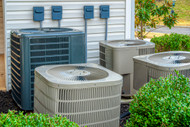How to Install an AC Unit
May 23rd 2024
Temperatures are rising and the hottest months of the year will be upon us soon. If your clients need you to install an air conditioning unit, there's no time like the present. When properly installed, the right AC unit can make a world of difference when it comes to getting your client’s household through the summer months in relative comfort.
In this guide, we'll walk you through how to install an AC unit to beat the heat this summer.
Choose the Right AC Unit
Choose an AC unit that's appropriate for the household in question and consider factors like room or home size, energy efficiency ratings, and budget. For example, a window air conditioner might be ideal for smaller spaces or single rooms, while a standalone system is better for larger homes. Research your options carefully to start your project off on the right foot.
Gather Your Tools & Materials
Make sure that you're ready to install the air conditioner by verifying that you've gathered all the tools and materials you're going to need. Read the instruction manual that comes with the unit thoroughly so that you're aware of exactly what you're going to need throughout the installation. Tools like screws, brackets, a leveler, refrigerant, insulated ductwork, and a drill are among the most common supplies that AC installations call for.
In addition, it's a good idea to have safety gear handy, such as gloves or goggles.
Select The AC Unit’s Location
If you're going to install a window AC unit, choose a window that's close to a power outlet and away from any obstructions (such as shrubs or sheds). For split systems or mini-splits, find a clear, level outdoor spot for the condenser unit and an indoor location for the air handler. Think about accessibility so that you can easily maintain the unit when the need arises.
Install Mounting Hardware
Window units need to be secured using mounting hardware, so if you're working with a unit of this type, make sure that you install the mounting brackets securely. Use a leveler to ensure that the unit is sitting evenly in the window space, and follow your instruction manual to verify that you're handling each step of the installation correctly.
For split systems, mount the indoor air handler on a sturdy wall and place the outdoor condenser unit on a flat space that's free from debris.
Secure the Unit
Once you've prepared the mounting brackets or the designated space for the split system, move the unit into position. Ensure that it fits snugly in either the window frame or the space you've chosen. Use the screws that came with the unit to secure it in place and make sure that it's stable.
When you're satisfied with the placement, you can use air conditioner sealant in any small gaps you see to prevent air leaks. Should an air leak occur during the installation process, apply AC unit sealant to the affected area. This material temporarily seals leaks so that the unit can continue to cool the house between now and when more permanent, professional repairs take place.
Connect the Electrical Wiring
For window units, plug the AC into the outlet you're going to use and secure the power cord so that no one in the home trips over it. If you're installing a split or mini-split system and aren’t an electrician yourself, it may be best to work with a licensed electrician to connect the indoor and outdoor units to the house's electrical system. This way, you can ensure that the installation is both safe and correct.
Install the Ductwork
If you've installed a central AC unit, connect the ductwork to the air handler and install vents throughout the home. Tape off duct joints to permanently seal them, prevent air leaks, and ensure that the system is working efficiently.
Maintain the AC Unit
After you've tested the AC unit to make sure it works properly, you'll want to keep the system running smoothly. Have your clients inspect their AC units on a regular basis and call you to perform maintenance tasks as needed. For example, the filters will need to be cleaned or replaced every couple of months, debris will need to be cleared from around the unit, and professional tune-ups may need to happen seasonally.
Installing an AC unit can be challenging, but by following instructions carefully, you can pull it off. For high-quality silicone sealant that will make this task as easy as possible, consider browsing Silicone Depot’s selection of silicone sealant and caulk.

